wheel FIAT STRADA 2011 Owner handbook (in English)
[x] Cancel search | Manufacturer: FIAT, Model Year: 2011, Model line: STRADA, Model: FIAT STRADA 2011Pages: 195, PDF Size: 3.68 MB
Page 91 of 195
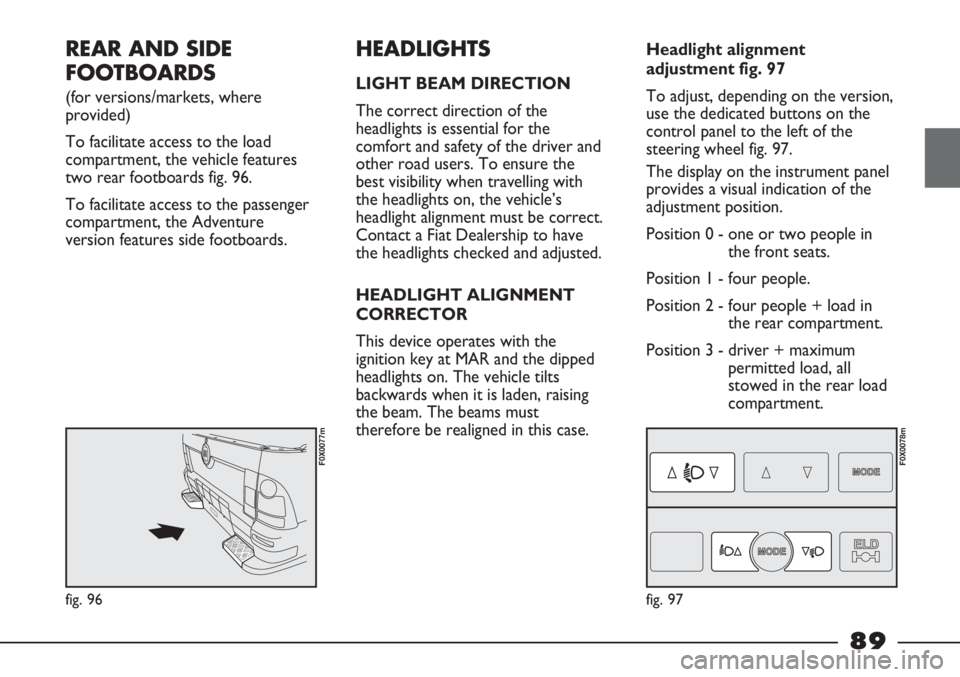
REAR AND SIDE
FOOTBOARDS
(for versions/markets, where
provided)
To facilitate access to the load
compartment, the vehicle features
two rear footboards fig. 96.
To facilitate access to the passenger
compartment, the Adventure
version features side footboards.
HEADLIGHTS
LIGHT BEAM DIRECTION
The correct direction of the
headlights is essential for the
comfort and safety of the driver and
other road users. To ensure the
best visibility when travelling with
the headlights on, the vehicle’s
headlight alignment must be correct.
Contact a Fiat Dealership to have
the headlights checked and adjusted.
HEADLIGHT ALIGNMENT
CORRECTOR
This device operates with the
ignition key at MAR and the dipped
headlights on. The vehicle tilts
backwards when it is laden, raising
the beam. The beams must
therefore be realigned in this case.Headlight alignment
adjustment fig. 97
To adjust, depending on the version,
use the dedicated buttons on the
control panel to the left of the
steering wheel fig. 97.
The display on the instrument panel
provides a visual indication of the
adjustment position.
Position 0 - one or two people in
the front seats.
Position 1 - four people.
Position 2 - four people + load in
the rear compartment.
Position 3 - driver + maximum
permitted load, all
stowed in the rear load
compartment.
fig. 97
F0X0078m
fig. 96
F0X0077m
89
Page 92 of 195
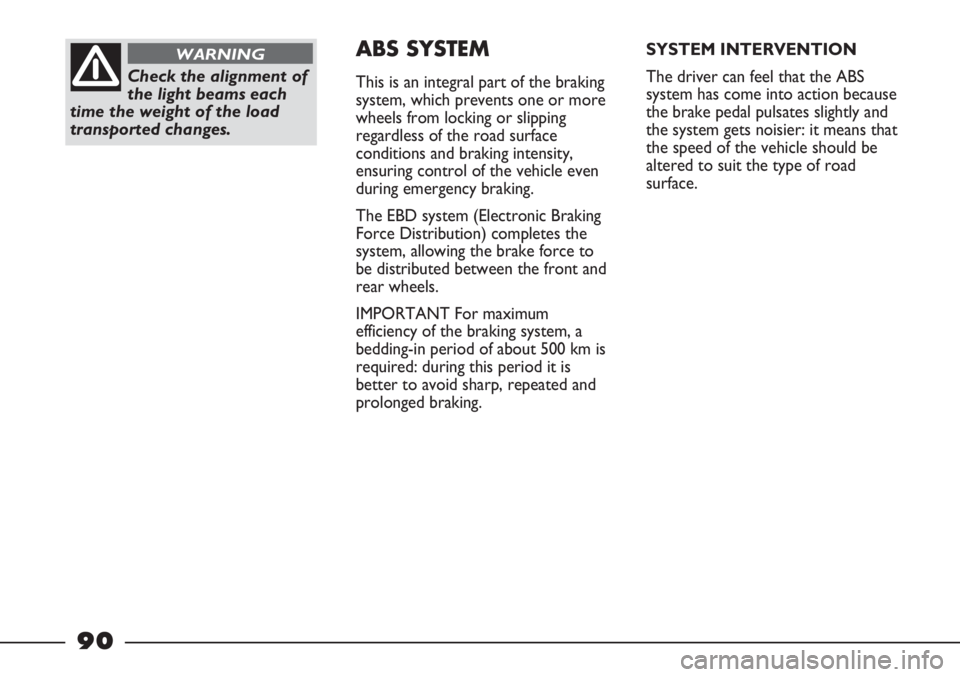
Check the alignment of
the light beams each
time the weight of the load
transported changes.
WARNINGABS SYSTEM
This is an integral part of the braking
system, which prevents one or more
wheels from locking or slipping
regardless of the road surface
conditions and braking intensity,
ensuring control of the vehicle even
during emergency braking.
The EBD system (Electronic Braking
Force Distribution) completes the
system, allowing the brake force to
be distributed between the front and
rear wheels.
IMPORTANT For maximum
efficiency of the braking system, a
bedding-in period of about 500 km is
required: during this period it is
better to avoid sharp, repeated and
prolonged braking.SYSTEM INTERVENTION
The driver can feel that the ABS
system has come into action because
the brake pedal pulsates slightly and
the system gets noisier: it means that
the speed of the vehicle should be
altered to suit the type of road
surface.
90
Page 93 of 195
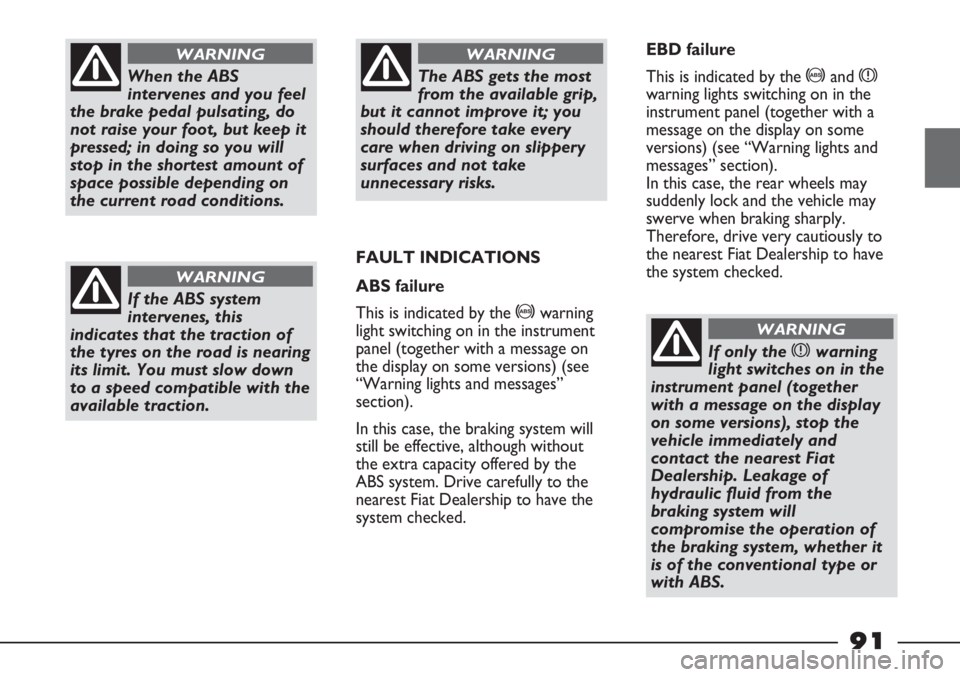
When the ABS
intervenes and you feel
the brake pedal pulsating, do
not raise your foot, but keep it
pressed; in doing so you will
stop in the shortest amount of
space possible depending on
the current road conditions.
WARNING
If the ABS system
intervenes, this
indicates that the traction of
the tyres on the road is nearing
its limit. You must slow down
to a speed compatible with the
available traction.
WARNING
The ABS gets the most
from the available grip,
but it cannot improve it; you
should therefore take every
care when driving on slippery
surfaces and not take
unnecessary risks.
WARNING
FAULT INDICATIONS
ABS failure
This is indicated by the >warning
light switching on in the instrument
panel (together with a message on
the display on some versions) (see
“Warning lights and messages”
section).
In this case, the braking system will
still be effective, although without
the extra capacity offered by the
ABS system. Drive carefully to the
nearest Fiat Dealership to have the
system checked. EBD failure
This is indicated by the >and x
warning lights switching on in the
instrument panel (together with a
message on the display on some
versions) (see “Warning lights and
messages” section).
In this case, the rear wheels may
suddenly lock and the vehicle may
swerve when braking sharply.
Therefore, drive very cautiously to
the nearest Fiat Dealership to have
the system checked.
If only the xwarning
light switches on in the
instrument panel (together
with a message on the display
on some versions), stop the
vehicle immediately and
contact the nearest Fiat
Dealership. Leakage of
hydraulic fluid from the
braking system will
compromise the operation of
the braking system, whether it
is of the conventional type or
with ABS.
WARNING
91
Page 94 of 195
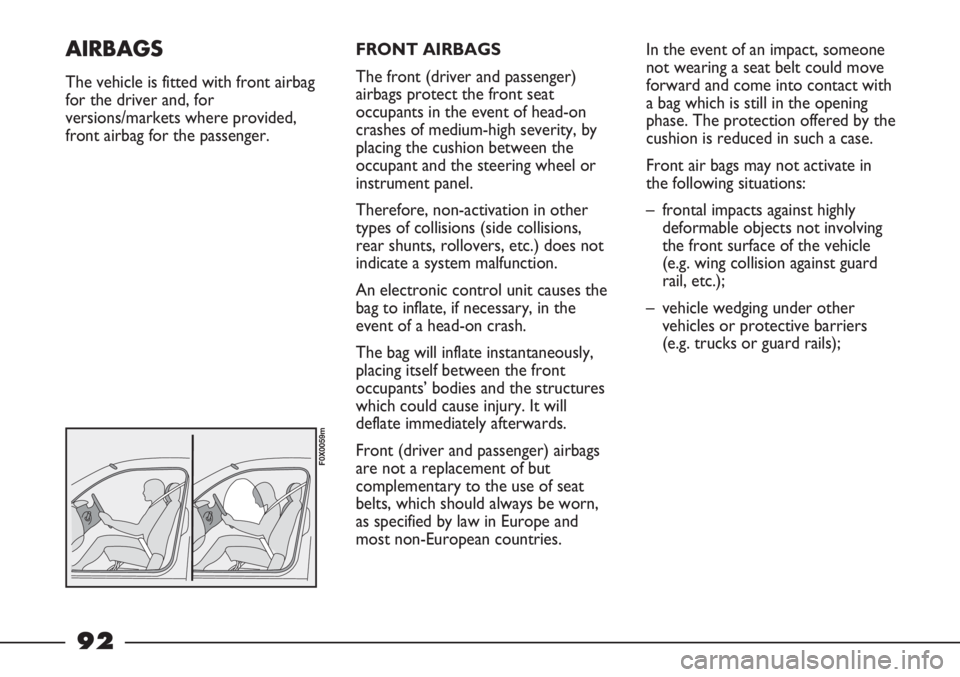
FRONT AIRBAGS
The front (driver and passenger)
airbags protect the front seat
occupants in the event of head-on
crashes of medium-high severity, by
placing the cushion between the
occupant and the steering wheel or
instrument panel.
Therefore, non-activation in other
types of collisions (side collisions,
rear shunts, rollovers, etc.) does not
indicate a system malfunction.
An electronic control unit causes the
bag to inflate, if necessary, in the
event of a head-on crash.
The bag will inflate instantaneously,
placing itself between the front
occupants’ bodies and the structures
which could cause injury. It will
deflate immediately afterwards.
Front (driver and passenger) airbags
are not a replacement of but
complementary to the use of seat
belts, which should always be worn,
as specified by law in Europe and
most non-European countries.In the event of an impact, someone
not wearing a seat belt could move
forward and come into contact with
a bag which is still in the opening
phase. The protection offered by the
cushion is reduced in such a case.
Front air bags may not activate in
the following situations:
– frontal impacts against highly
deformable objects not involving
the front surface of the vehicle
(e.g. wing collision against guard
rail, etc.);
– vehicle wedging under other
vehicles or protective barriers
(e.g. trucks or guard rails);AIRBAGS
The vehicle is fitted with front airbag
for the driver and, for
versions/markets where provided,
front airbag for the passenger.
F0X0059m
92
Page 95 of 195
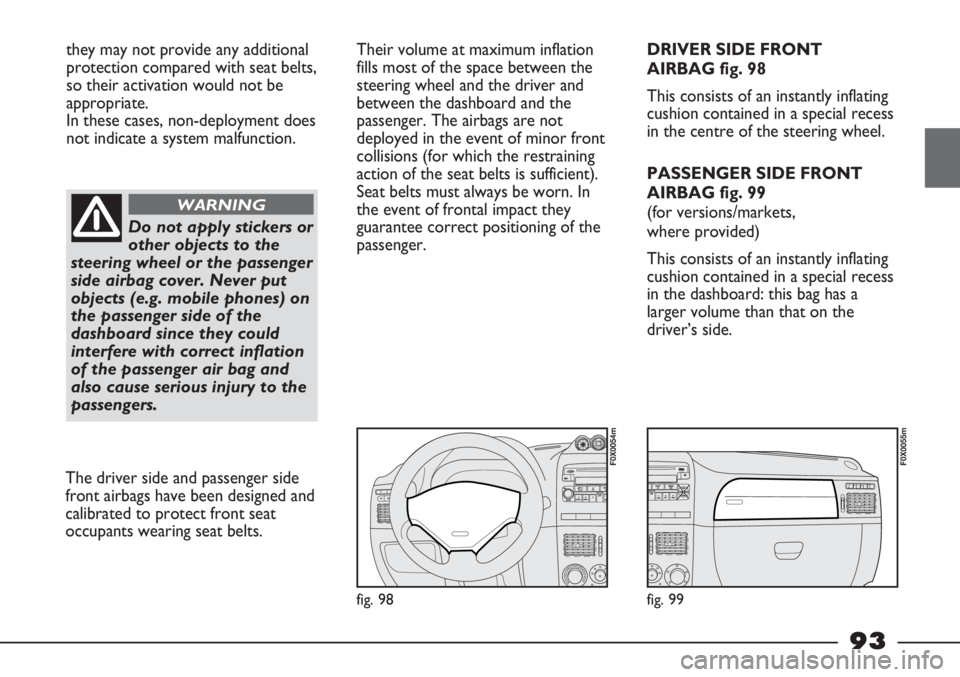
they may not provide any additional
protection compared with seat belts,
so their activation would not be
appropriate.
In these cases, non-deployment does
not indicate a system malfunction.
Do not apply stickers or
other objects to the
steering wheel or the passenger
side airbag cover. Never put
objects (e.g. mobile phones) on
the passenger side of the
dashboard since they could
interfere with correct inflation
of the passenger air bag and
also cause serious injury to the
passengers.
WARNING
Their volume at maximum inflation
fills most of the space between the
steering wheel and the driver and
between the dashboard and the
passenger. The airbags are not
deployed in the event of minor front
collisions (for which the restraining
action of the seat belts is sufficient).
Seat belts must always be worn. In
the event of frontal impact they
guarantee correct positioning of the
passenger.
fig. 99
F0X0055m
fig. 98
F0X0054m
DRIVER SIDE FRONT
AIRBAG fig. 98
This consists of an instantly inflating
cushion contained in a special recess
in the centre of the steering wheel.
PASSENGER SIDE FRONT
AIRBAG fig. 99
(for versions/markets,
where provided)
This consists of an instantly inflating
cushion contained in a special recess
in the dashboard: this bag has a
larger volume than that on the
driver’s side.
The driver side and passenger side
front airbags have been designed and
calibrated to protect front seat
occupants wearing seat belts.
93
Page 99 of 195
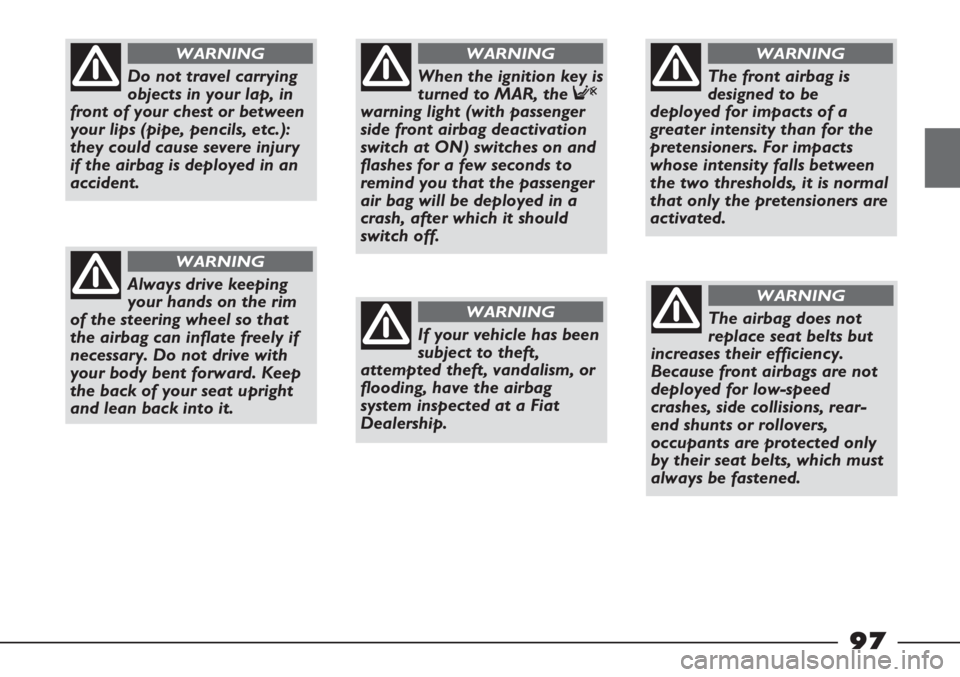
97
Do not travel carrying
objects in your lap, in
front of your chest or between
your lips (pipe, pencils, etc.):
they could cause severe injury
if the airbag is deployed in an
accident.
WARNING
Always drive keeping
your hands on the rim
of the steering wheel so that
the airbag can inflate freely if
necessary. Do not drive with
your body bent forward. Keep
the back of your seat upright
and lean back into it.
WARNING
When the ignition key is
turned to MAR, the F
warning light (with passenger
side front airbag deactivation
switch at ON) switches on and
flashes for a few seconds to
remind you that the passenger
air bag will be deployed in a
crash, after which it should
switch off.
WARNING
If your vehicle has been
subject to theft,
attempted theft, vandalism, or
flooding, have the airbag
system inspected at a Fiat
Dealership.
WARNING
The front airbag is
designed to be
deployed for impacts of a
greater intensity than for the
pretensioners. For impacts
whose intensity falls between
the two thresholds, it is normal
that only the pretensioners are
activated.
WARNING
The airbag does not
replace seat belts but
increases their efficiency.
Because front airbags are not
deployed for low-speed
crashes, side collisions, rear-
end shunts or rollovers,
occupants are protected only
by their seat belts, which must
always be fastened.
WARNING
Page 100 of 195
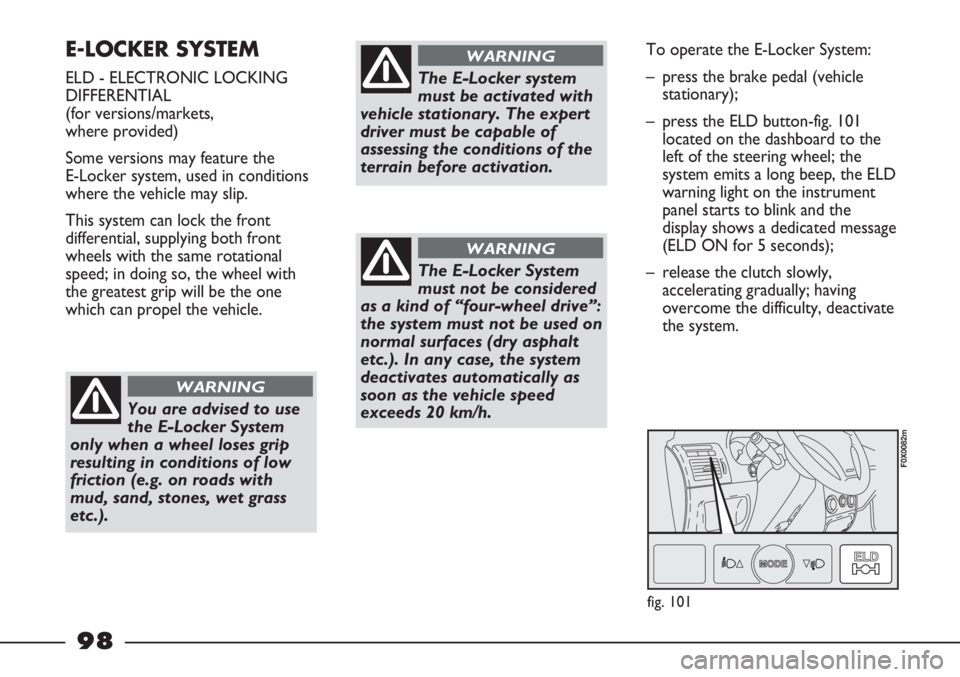
E-LOCKER SYSTEM
ELD - ELECTRONIC LOCKING
DIFFERENTIAL
(for versions/markets,
where provided)
Some versions may feature the
E-Locker system, used in conditions
where the vehicle may slip.
This system can lock the front
differential, supplying both front
wheels with the same rotational
speed; in doing so, the wheel with
the greatest grip will be the one
which can propel the vehicle.
The E-Locker System
must not be considered
as a kind of “four-wheel drive”:
the system must not be used on
normal surfaces (dry asphalt
etc.). In any case, the system
deactivates automatically as
soon as the vehicle speed
exceeds 20 km/h.
WARNING
You are advised to use
the E-Locker System
only when a wheel loses grip
resulting in conditions of low
friction (e.g. on roads with
mud, sand, stones, wet grass
etc.).
WARNING
To operate the E-Locker System:
– press the brake pedal (vehicle
stationary);
– press the ELD button-fig. 101
located on the dashboard to the
left of the steering wheel; the
system emits a long beep, the ELD
warning light on the instrument
panel starts to blink and the
display shows a dedicated message
(ELD ON for 5 seconds);
– release the clutch slowly,
accelerating gradually; having
overcome the difficulty, deactivate
the system.
The E-Locker system
must be activated with
vehicle stationary. The expert
driver must be capable of
assessing the conditions of the
terrain before activation.
WARNING
fig. 101
F0X0082m
98
Page 101 of 195
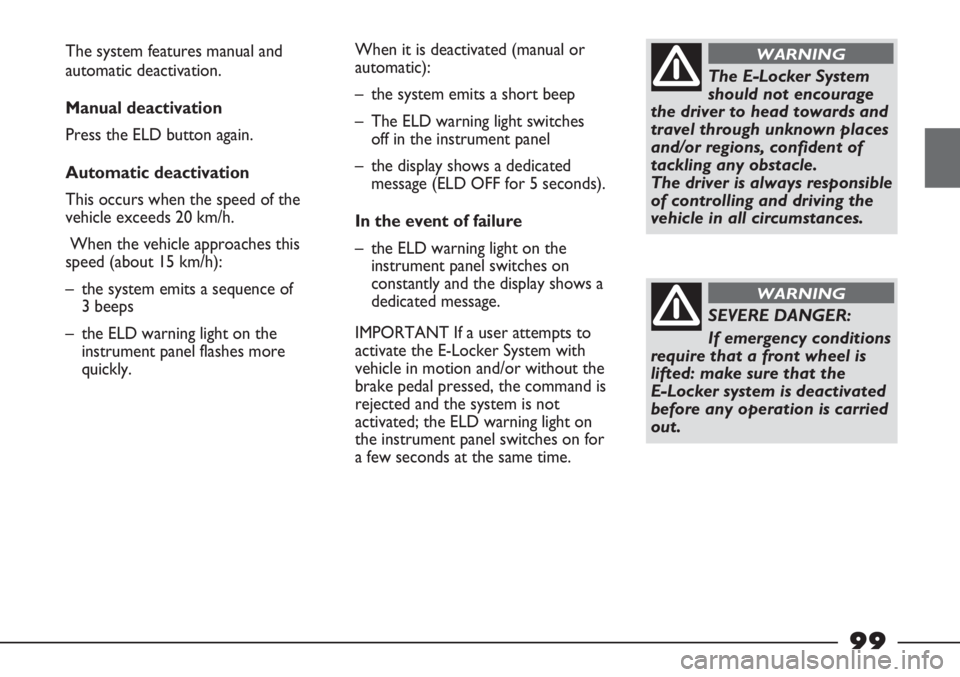
The E-Locker System
should not encourage
the driver to head towards and
travel through unknown places
and/or regions, confident of
tackling any obstacle.
The driver is always responsible
of controlling and driving the
vehicle in all circumstances.
WARNING
SEVERE DANGER:
If emergency conditions
require that a front wheel is
lifted: make sure that the
E-Locker system is deactivated
before any operation is carried
out.
WARNING
The system features manual and
automatic deactivation.
Manual deactivation
Press the ELD button again.
Automatic deactivation
This occurs when the speed of the
vehicle exceeds 20 km/h.
When the vehicle approaches this
speed (about 15 km/h):
– the system emits a sequence of
3 beeps
– the ELD warning light on the
instrument panel flashes more
quickly.When it is deactivated (manual or
automatic):
– the system emits a short beep
– The ELD warning light switches
off in the instrument panel
– the display shows a dedicated
message (ELD OFF for 5 seconds).
In the event of failure
– the ELD warning light on the
instrument panel switches on
constantly and the display shows a
dedicated message.
IMPORTANT If a user attempts to
activate the E-Locker System with
vehicle in motion and/or without the
brake pedal pressed, the command is
rejected and the system is not
activated; the ELD warning light on
the instrument panel switches on for
a few seconds at the same time.
99
Page 107 of 195
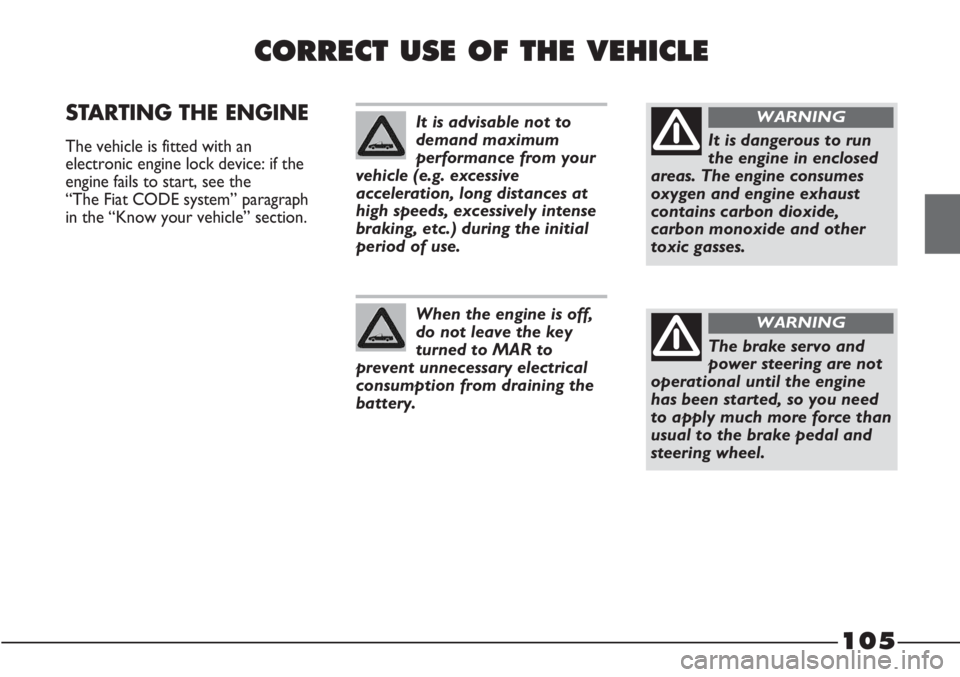
105
CORRECT USE OF THE VEHICLE
STARTING THE ENGINE
The vehicle is fitted with an
electronic engine lock device: if the
engine fails to start, see the
“The Fiat CODE system” paragraph
in the “Know your vehicle” section.
It is advisable not to
demand maximum
performance from your
vehicle (e.g. excessive
acceleration, long distances at
high speeds, excessively intense
braking, etc.) during the initial
period of use.
When the engine is off,
do not leave the key
turned to MAR to
prevent unnecessary electrical
consumption from draining the
battery.
It is dangerous to run
the engine in enclosed
areas. The engine consumes
oxygen and engine exhaust
contains carbon dioxide,
carbon monoxide and other
toxic gasses.
WARNING
The brake servo and
power steering are not
operational until the engine
has been started, so you need
to apply much more force than
usual to the brake pedal and
steering wheel.
WARNING
Page 109 of 195
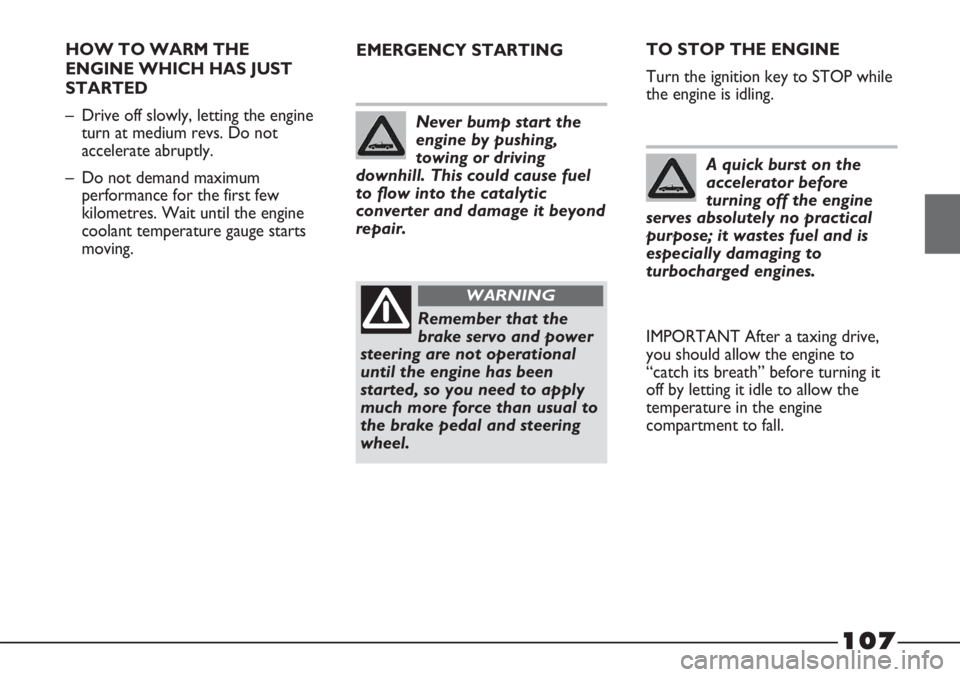
107
HOW TO WARM THE
ENGINE WHICH HAS JUST
STARTED
– Drive off slowly, letting the engine
turn at medium revs. Do not
accelerate abruptly.
– Do not demand maximum
performance for the first few
kilometres. Wait until the engine
coolant temperature gauge starts
moving.EMERGENCY STARTING
Never bump start the
engine by pushing,
towing or driving
downhill. This could cause fuel
to flow into the catalytic
converter and damage it beyond
repair.
Remember that the
brake servo and power
steering are not operational
until the engine has been
started, so you need to apply
much more force than usual to
the brake pedal and steering
wheel.
WARNING
TO STOP THE ENGINE
Turn the ignition key to STOP while
the engine is idling.
A quick burst on the
accelerator before
turning off the engine
serves absolutely no practical
purpose; it wastes fuel and is
especially damaging to
turbocharged engines.
IMPORTANT After a taxing drive,
you should allow the engine to
“catch its breath” before turning it
off by letting it idle to allow the
temperature in the engine
compartment to fall.